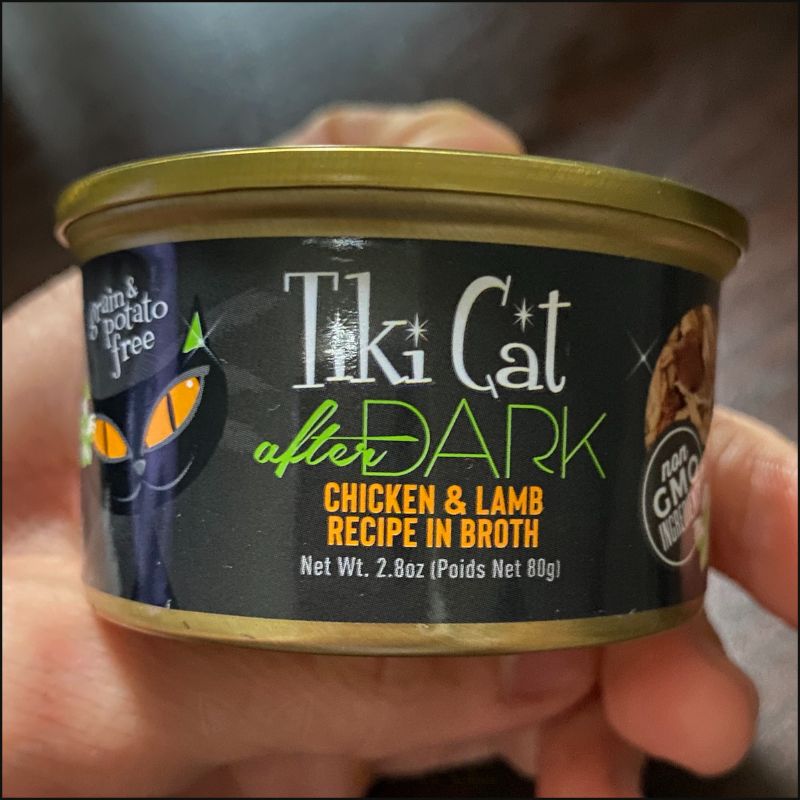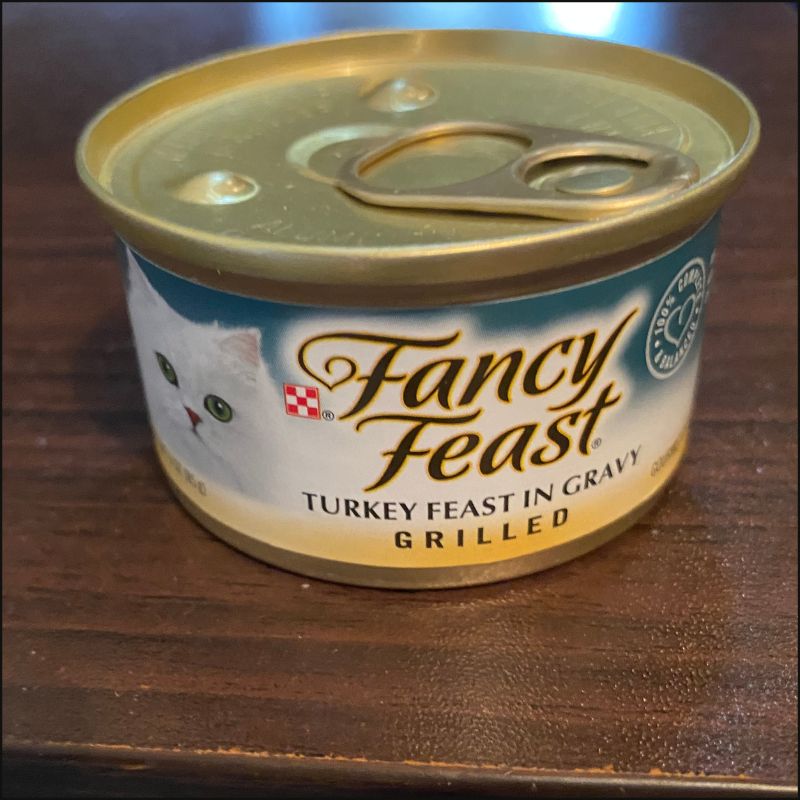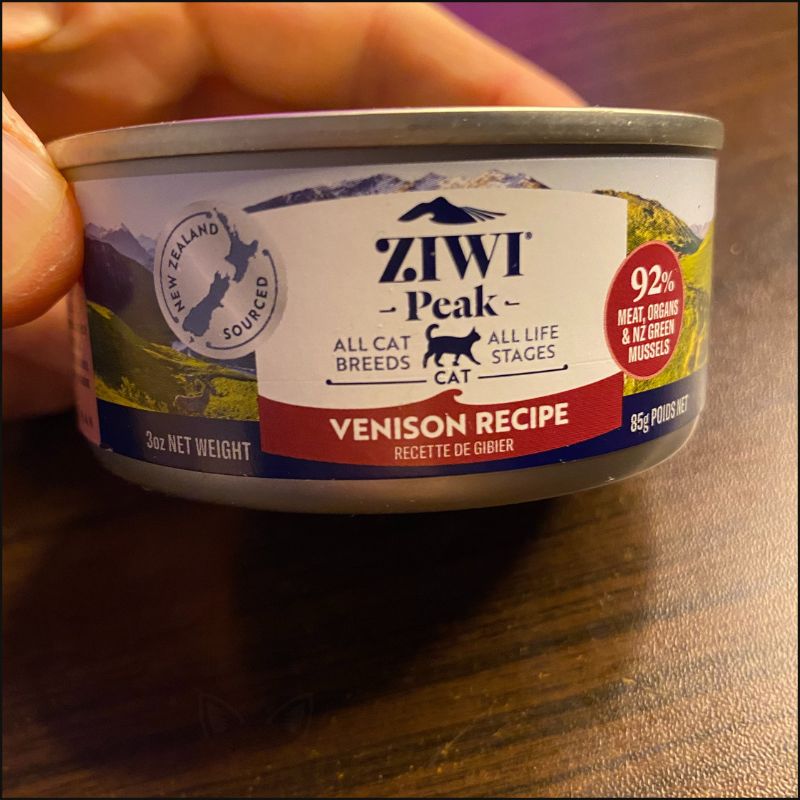Quick answer: Try an elimination diet with a single protein source, ideally novel protein.
This can help clear up diarrhea.
Cats may have food intolerances to wheat, barley, and have difficulty digesting high fiber foods like peas. Limit for best results.
3 Best Cat Food for Cats With Diarrhea
I filtered popular cat foods to use for diarrhea. All are the best rated from my testing.
Looked for:
- No grains
- No legumes (e.g. peas)
- Less than 12% carbohydrate (dry basis)
- Low residue/fiber (less than 10% dry basis)
- Single protein source
- Wet food
Tiki Cat After Dark is the best quality overall. I recommend it for most situations.
It’s hard to find a cat food that meets all criteria, but these options meet almost all of them.
More below in this guide to the best cat food for cats with diarrhea.
I have a background in nutrition and research and test most of the products recommended.
This article isn’t a replacement for medical advice.
See more about us here.
What to Look For in Cat Food for Diarrhea?
Quick answers:
- Consult a Vet First: Diarrhea can be caused by medical issues like parasites in kittens or hyperthyroidism in older cats. Also consult a vet if your cat experiences weight loss, loss of appetite, or bloody stools.
- Consider an Elimination Diet: This helps identify food intolerances or allergies which up to 11% of cats suffer from. Irritants include histamines, gluten, lactose, colorings, preservatives, flavorings, and lectins. Get them out of the diet.
- Switch to Wet Food or Novel Protein Diets: Includes things like kangaroo, lamb, turkey, duck, venison, or rabbit. This helps reduce ingredient variables and may lead to remission in many cases.
- Opt for Low Carb Cat Food: Since cats are carnivores and do not need carbs, diets with less than 12% carbs (dry basis) are recommended to prevent digestive issues.
- Try a Low Fiber Diet: Especially avoid soluble fibers like gums, pectin, and legumes which can draw in water and cause runnier stools.
- Choose Complete Cat Food: Ensure the food meets AAFCO nutrition guidelines to prevent nutrient deficiencies that may cause diarrhea.
Quick actionable steps:
- Rule out health issues with a vet visit.
- Implement an elimination diet to identify food sensitivities.
- Use wet food or foods with a single novel protein source.
- Select low carb and low fiber options.
- Ensure the cat food is a complete meal per AAFCO guidelines.
Long answers:
Here’s the steps to treat diarrhea in cats.
First, rule out any medical problems.
Kittens are at risk of parasites. Older cats can get diarrhea from issues like hyperthyroidism.
For kittens and senior cats, see a vet. Also see a vet if you notice weight loss, loss of appetite, or bloody poos.
If there’s no other issues, it’s time to try switching up diet.
Here’s our research backed tips:
Try an Elimination Diet
Is your cat sensitive to common ingredients?
Up to 11% of cats have food intolerances and/or allergies.
Some ingredients that cause food intolerance include:
- Histamines
- Gluten
- Lactose
- Colorings
- Preservatives
- Flavorings
- Lectins
How would a food intolerance cause diarrhea?
- Lack of digestive enzymes
- Changes to digestive system function (e.g. faster transit time)
Itchiness (pruritis) is a sign the diarrhea is food related.
So how does an elimination diet help?
It cuts down the variables. Less ingredients = less chance of problems.
49% of cats with gastrointestinal diseases including diarrhea respond to a change in diet.
Simply switching to wet food (less ingredients than dry) helps many cats to enter remission.
Vets also recommend single novel protein diets. This can help some cats find relief in less than 2 weeks.
Novel protein sources are anything your cat not exposed to.
Includes:
- Kangaroo
- Lamb
- Turkey
- Duck
- Venison
- Rabbit
Choose a cat food with one of these ingredients as a single protein source and try it.
In hard to treat cases, a hydrolyzed protein diet can help. In one study, 42% of cats went into remission with approach.
Choose Low Carb Cat Food
Cats are carnivores.
They have zero need for carbs. With fewer digestive enzymes, experts suggest limiting to less that 12% (dry basis).
Why?
Like someone with lactose intolerance drinking too much milk, cats can’t tolerate much carbs (unlike humans).
One study saw 46% diarrhea improvement with a low carb cat food, compared to only 13% with a high carb food.
Although it was using prescription cat food, it’s quite a difference.
Read more:
Try a Low Fiber Diet
Fiber can be a problem.
Some types of fiber (mainly soluble) are fermented in the gut. This includes gums, pectin, and legumes.
The soluble fiber can draw in water, potentially causing runny poos. Insoluble fiber speeds transit of poo.
This might be why high fiber diets seem to perform worse when treating diarrhea.
Try lowering fiber to see if it helps and avoiding legumes.
Choose Complete Cat Food
Make sure your cat gets enough.
Nutrient deficiencies may cause diarrhea, including a zinc deficiency.
Look for cat food that meets AAFCO’s nutrition guidelines as a complete meal. Usually on the back label.
Learn More:
FAQ
Quick answers:
- Wet vs. Dry Food for Diarrhea: Wet food is preferred for cats with diarrhea due to fewer ingredients and lower carbs.
- Causes of Diarrhea: High carbohydrate diets can cause diarrhea; limit carbs to less than 12% dry basis.
- Ingredients to Avoid: Histamines, gluten, lactose, colorings, preservatives, flavorings, lectins.
- Milk and Diarrhea: Limit milk intake due to cats’ low lactase levels, which can exacerbate diarrhea.
- Understanding Diarrhea: Diarrhea involves more water in feces, leading to liquid or partial liquid consistency.
- Diarrhea Prevalence: About 11.9% in shelter cats, with higher risks in kittens and enclosures.
- Reasons Cats Get Diarrhea: Physical or metabolic issues, infections, food allergies, intolerances affecting digestion.
- When to Call a Vet: If diarrhea persists over two days, or if there’s vomiting and loss of appetite.
- Vet Treatment: Diagnostics like physical exams, ultrasounds, bloodwork followed by diet or medication.
- Older Cats and Diarrhea: Less likely than younger cats, but more severe when it occurs.
- Dry Food and Diarrhea: Not recommended due to high carbs and lack of moisture.
- Preventing Diarrhea: Opt for wet, low-fiber cat food for easier digestion.
- Firming Stool: Add 1-2 teaspoons of psyllium (soluble fiber) to wet food.
- Food Withholding: Do not withhold food; wet food helps replace lost water and electrolytes from diarrhea.
- Other Causes of Diarrhea: Includes diseases, dehydration, and stress.
- Signs of Diarrhea: Includes lack of straining, weight loss, vomiting, increased litter box use.
Long answers:
Is Wet Food or Dry Food Better for Cats With Diarrhea?
Wet food is generally a better choice.
Wet food tends to have less ingredients and is lower in carbs. These factors may help clear up diarrhea.
Can Certain Cat Foods Cause Diarrhea in Cats?
Yes.
A high carbohydrate diet may cause diarrhea in cats. I recommend limiting to less than 12% carbs (dry basis).
Diet isn’t the only cause of diarrhea.
Other causes of diarrhea in cats include:
- Infectious and non-infectious diseases
- Dehydration
- Stress
If switching up diet doesn’t help with diarrhea, take a trip to the vet for a workup.
What Ingredients Should I Avoid to Help My Cat With Diarrhea?
Here’s things to avoid:
- Histamines
- Gluten
- Lactose
- Colorings
- Preservatives
- Flavorings
- Lectins
It’s hard to avoid all of these ingredients, unless you look for high quality cat food.
Is Milk Bad for Cats With Diarrhea?
Maybe.
Cats can tolerate about 1/4 cup of milk per day. Milk contains lactose, a sugar cats have a hard time digesting.
This is due to low amounts of lactase, an enzyme used to break down milk sugar.
Learn more:
What is Cat Diarrhea?
Diarrhea is a condition that causes more water is in the feces. This results in either a liquid or partial liquid consistency poo.
Other signs of diarrhea include:
- Lack of straining
- Weight loss
- Vomiting
- Increased litter box usage
How Common Is Diarrhea in Cats?
Research data on 1,727 cats admitted to shelters find the prevalence of diarrhea is 11.9%.
Kittens and multiple cats living in an enclosure have a higher risk of diarrhea. Cats living together pass infections more readily.
Why Do Cats Get Diarrhea?
Diarrhea is caused by any one of following problems:
- A physical problem with the digestive system (e.g. short bowel syndrome)
- Metabolic problems (e.g. hyperthyroidism)
- Infections
- Food allergy
- Food intolerance
These problems affect the digestion of food and how much water is in the feces.
They affect the following areas of digestion:
- Transit time (i.e. how fast food moves through digestion)
- Water absorption
- Gut bacteria (affects transit time)
Get a workup from the vet to find the cause of the problem.
Seek medical help for bouts of diarrhea that last more than two days and/or results in a loss of appetite.
When Should I Call a Vet if My Cat Has Diarrhea?
If diarrhea lasts more than two days, call a vet.
According to VCA Hospitals, vomiting and loss of appetite are signs your cat needs immediate medical attention.
How Do Vets Treat Diarrhea in Cats?
A vet will go through a variety of diagnostic tests to find out the cause of the problem, before providing a treatment plan.
This includes the following:
- Physical workup
- Ultrasound
- Bloodwork
The treatment can involve dietary suggestions and/or medication.
If diarrhea lasts more than two days, call a vet.
Do Older Cats Have Diarrhea More Often?
No.
Older cats are less likely to experience diarrhea. Senior cats are more likely to experience constipation.
Older cats do have severe diarrhea more often than young cats, although the overall prevalence is low.
Learn more:
Does Dry Cat Food Help With Diarrhea?
No.
Dry cat food is higher in carbohydrate, which cats find harder to digest in high amounts.
High carb diets can result in diarrhea.
Dry food also lacks moisture, which is important to maintain hydration.
How Can I Prevent Cat Diarrhea?
Try a wet canned cat food that is low in fiber.
This type of cat food is easier on the gut.
How Can I Firm up My Cat’s Stool?
Adding fiber can help improve your cats stool. There are two types of fiber:
- Soluble
- Insoluble
These types of fiber have different effects. Insoluble fiber bulks up stool, whilst soluble increases moisture.
1-2 teaspoons of psyllium (soluble fiber) added to wet cat food can help cats find relief.
Another popular remedy is pumpkin, but research suggests cooked pumpkin doesn’t help with diarrhea. Your mileage may vary.
Should You Withhold Food From Cats With Diarrhea?
No.
Wet cat food is a source of water and electrolytes which help replace losses from diarrhea.
I recommend cutting out dry food from the diet and sticking to wet foods. These options are easier to digest and less likely to result in further diarrhea episodes.
Conclusion
Diarrhea in cats is a problem involving watery feces.
This can be a serious problem caused by parasites, tumors, or toxic substances.
See a vet if the problem persists for over two days.
Dietary solutions include:
- Lowering fiber
- Elimination diet
- Limiting high carb foods
- Switching to a wet food diet
- Avoid common food irritants (e.g. lectins, gluten)
Recommended: Tiki Cat After Dark.




